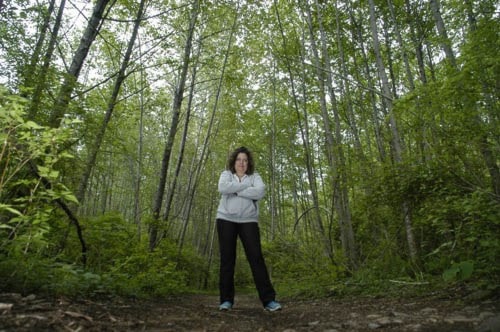A few times a week, Joanne Jonas escapes the hectic life of the city and enters a cool, green world of forests, beaver ponds and meandering trails.
She doesn’t have to go far to get there.
The trailhead to the western edge of the Linley Valley is just two blocks from her front door, and she treasures the solitude and silence that is interrupted only by the slap of a beaver tail or song of a bird. Sometimes she takes her camera and photographs a heron that often perches on its favourite log.
That all changed last week when she discovered her favourite trail near the end of Altavista Drive, one she describes as a beautiful forested path, was destroyed in preparation for the development of 195 units on the 24-hectare property.
Last year the developer, Lamont Land Inc., also reworked a natural beaver pond and replaced it with a man-made one, while adhering to all city and provincial requirements.
“It’s sad, this place has the feel of the country and it’s right in the city,” said Jonas, while hiking another trail on the property still intact. “I’m afraid we’re going to lose all of this forest that is private land at some point. There isn’t as much value in a styled, manicured park or pond as there is in a natural one.”
Jonas said she comes across hikers, bikers and dog walkers every day on the trails who are surprised to hear that the forest is not protected.
On Tuesday, she had a trailside chat with walkers Brian and Sandra Rodwell, who had heard a different version of the developer’s plans.
“We heard that the trails were to be preserved,” said Sandra. “And we also thought these ponds and that bluff were protected, but maybe not. It would be a shame to lose them. We come through here quite often.”
Brian Henning of Williamson and Associates, working on behalf of Lamont, said considerable effort was made to adhere to all development requirements and that the company considers features like ponds and trails as valuable.
“Water features like beaver ponds are positive features in any development,” said Henning. “But when it comes to beaver dams, there are provincial regulations we have to follow. With natural dams, water levels go up and down significantly, or the dam breaks. We have to ensure property won’t be damaged if that happens so we install a reworked permanent dam.”
Linley Valley, considered a secret gem in Nanaimo, includes about 325 hectares of still undeveloped wildlife corridor that is home to a wide variety of birds, deer, beavers, fish and two cougars known to live in the area.
The Nanaimo and Area Land Trust raised $500,000 between 2001 and 2003 and partnered with the city, which put in $1.6 million, to secure 59 hectares in the centre of the valley as city park.
After a public consultation process last year, the province put 101-hectares along the east park boundary, known as the DL 56 lot, under a new land use order protecting it from development, due to its value as a vulnerable coastal Douglas fir ecosystem.
About half of the valley remains unprotected and vulnerable to development.
Along with the Lamont development off Rutherford Road, six hectares of forest is also being prepared for development off Linley Road.
“That top part of the valley, according to all of our maps, was never protected,” said Gail Adrienne, executive director of NALT. “We’re sort of resigned to the fact that development is going to happen there. It’s private land, it always has been, and there is really nothing we can do about it. We wish we could save it all, but we can’t.”
Jonas said she understands development and is not against it – her house was built in an area that was once second-growth forest – she just wants people to be aware of what the city residents stand to lose and to work toward improving development practices so that more nature in the future can be left intact for future generations to enjoy.
“It’s areas like this that make Nanaimo unique and this is why people choose to live here and I see the Catch-22 there,” said Jonas. “But this is an important wildlife corridor and it saddens me to think it can just be bulldozed. We need to find a better way and that won’t happen unless people who live here become aware.”
Henning said wildlife corridors will be preserved with 15-metre setbacks on each side of McGregor Creek, and that bluffs and ridges in the area are not scheduled to be developed. Five per cent of the development, not including riparian setbacks, will be set aside as park, and a paved multi-use trail and soft trail are also planned.
He added that Lamont has worked with biologists and environmental consultants on the property since 2005.
Adrienne said while local development practises regarding the environment have come a long way, there is still plenty of room for improvement.
“About 15 years ago there was some horrific development just downstream from there where a bulldozer was literally stripping the hillside and the nearby wetland became chock-a-block full of mud,” she said. “The city has improved on that, they work with the developer to leave a bit of a strip around the wetlands and the city’s planning department has improved from that style 15 years ago, but it still makes a mess.”
Henning said there is constant dialogue between developers, municipalities and the province to improve the impact of development on the environment, but as the availability of flat land decreases, the challenges increase.
Jonas said she wants to generate an awareness campaign so that information regarding development plans are clear and residents understand what can and can’t be done under municipal and provincial regulations.
She can be reached by e-mail at driftwoodart2003@yahoo.ca.
